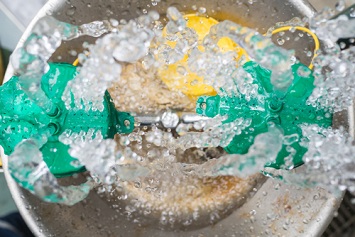Experts at Safety.BLR.com® were recently asked, “I need information on portable eyewash stations. Can we use a tank and water hose?” Unless the water is appropriately treated and at the right temperature, the answer is no. Read on for more details on portable eyewash stations.
OSHA itself has limited requirements for eyewash stations. Under its general industry standard for first aid, OSHA requires employers to provide suitable facilities for immediate emergency use within the work area for quick flushing of the eyes where a person’s eyes may be exposed to corrosive materials.
However, OSHA refers employers to the American National Standards Institute (ANSI) Z358.1 Standard for Emergency Eyewash and Shower Equipment for guidance about the installation, operation, and maintenance of eyewash stations when employees are exposed to hazardous materials and has enforced it during inspections.
Since ANSI standards are copyright protected and BLR does not have permission to reproduce them, we cannot discuss the extensive requirements of Z358.1 in detail. However, some of the requirements for portable eyewash stations include that they must be self-contained gravity-fed units with their own flushing fluid that must be replaced after each use. Portable eyewash stations do not require plumbing and must deliver their flushing fluid via potable water (tap water) treated with bacteriostatic solution or via a sealed cartridge with a contaminant-free purified or sterile solution. Additionally, the water temperature for the flushing fluid in an eyewash station must be tepid, which is between 60° and 100° F. To answer the original question, you may not use a water hose unless the water has been appropriately treated and purified and is the appropriate temperature.
Additionally, the ANSI standard recommends that portable eyewash stations use a preserved, buffered pH-balanced saline solution instead of plain tap water because tap water can damage healthy eyes. Using tap water also requires more maintenance because the unit needs weekly maintenance to remove contaminants, such as mildew, bacterial growth, and sediment buildup.
Other requirements for portable eyewash stations to keep in mind include:
- Required flushing of 0.4 gallons per minute (GPM) at 30 PSI for a full 15 minutes.
- Hands-free stay-open valve should activate in one second or less.
- The heads of the units (water flow pattern) must be positioned 33″ to 53″ from the surface on which the user stands and 6″ minimum from the wall.
- Eyewash fluid must irrigate and flush both eyes simultaneously.
- Units must be located no more than 10 seconds (or about 55 feet) from hazardous work areas and on the same level as the hazard. There must be a clear path for travel, and units must be installed in a well-lit area and marked with a visible safety sign.
For more information about the ANSI standard’s extensive installation, operation, maintenance, and training requirements for eyewash stations, see Z358.1, available for purchase from https://webstore.ansi.org.

